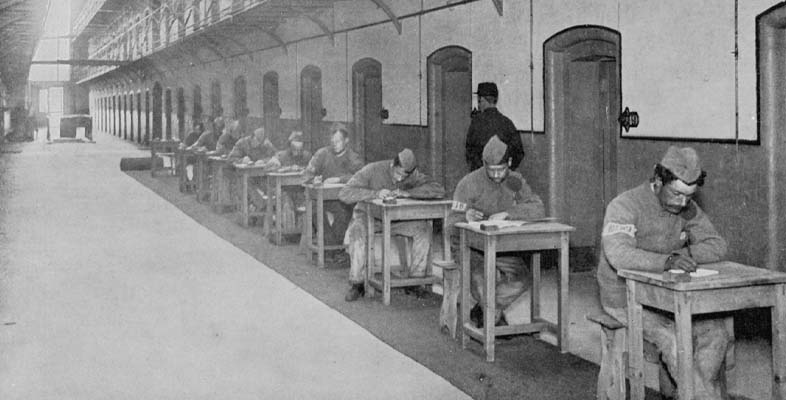1 Prison registers
In the early 1800s, officials at local prisons had significant latitude to design their own systems of record-keeping. At just about every prison there was a register (sometimes called a receiving book) to record the arrival and departure of prisoners. Some officials found they could not squeeze all the information they wanted into the register, and so invented new types of records to store additional details about prisoners. Officials at Ilchester County Gaol in Somerset, England kept both a ‘prison register’ and a ‘description book’.
Box 1 Notes for reading Figure 2
Handwriting from the early 1800s can be hard to read, so here are some notes to help you to decode Figure 2 if you need them.
The names of prisoners incarcerated in the gaol are provided in the second column. There is a note at the top of the list which says ‘Returned from Wells Sessions’, meaning that the men in this list have returned to the prison having been convicted at their trial held in the courthouse at Wells. They had probably been held on remand (awaiting trial) at Ilchester Gaol before their conviction.
The titles of the other columns in the description book are as follows (left to right): age, height, complexion, hair, eyes, remarks (used in this book to record further physical characteristics, such as scars, moles and tattoos), where born, trade, last place of abode (i.e. residence), married or single, number of children, read, and write.
Activity 1 Recording education in prison registers
Using the information in the Ilchester Gaol description book (Figure 2 and associated notes), try to answer the following questions:
- Can you identify the column(s) in which information about a prisoner’s previous education was noted?
- What types of information being collected here would support the argument that prison registers were used to increase the control of the state over the lives of individuals?
- What types of information being collected here would support the argument that prison registers were an early form of ‘criminology’, the study of criminal lives in order to better understand the causes of crime?
- Can you think of any other reason for collecting information on the previous education of prisoners?
Discussion
- Information about a prisoner’s previous education was noted in two columns: ‘Read’ and ‘Write’. If a prisoner was able to read, an ‘R’ was placed in the column headed ‘Read’. If a prisoner was able to write, a ‘W’ was placed in the column headed ‘Write’. In the early 1800s, pupils were often taught to read before they were taught to write. Many working-class children (and adults) left education before they learned to write. Some schools only taught pupils how to read (and not to write). Two prisoners listed on this page of the Ilchester Gaol description book could only read and not write. Sometimes prison officials relied on prisoners to tell them if they could read or read and write. Other times prisoners’ skills were tested, for example, by reading aloud a passage from the Bible or by writing it out.
- There are several types of information collected here that could be used by the state to exert control over the lives of individuals. Information on physical characteristics – height, eye and hair colour, and descriptions of distinguishing marks – could be used to identify these men as former prisoners after their release. Similarly, information on a prisoner’s ‘last place of abode’ could be used by the authorities to track down former prisoners and to keep an eye on them. (However, it should be noted that in the early 1800s there were few agencies able to take advantage of this information either to watch or to identify former prisoners. Policing was reactive and limited in scope. Probation services did not exist (Shoemaker and Ward, 2017, pp. 1442–6).)
- Many types of information collected in the description book could be used to investigate the ‘character of the criminal’ and the causes of crime. Information on age could be used by contemporaries to investigate the extent of youth crime. Information on marital status and progeny (i.e. number of children) could provide similar evidence on either the causes of crime (the need to provide for a family) or on patterns of desistance (that getting married and having children acts as a brake on criminal activity). Place of birth and place of abode could tell contemporaries whether convicted criminals were more likely to come from certain areas. Information on literacy – the ability to read and write – could be used to prove or disprove a link between the lack of education and the commission of crime.
- There may have been a functional reason for the collection of information on prisoners’ literacy. In order to teach prisoners how to read and write prison officials needed to know who could already read, read and write, or do neither. Surviving registers from the period before 1835 suggest that there was a close relationship between the collection of information on prisoner literacy and the existence of a prison school. For example, the introduction of description books at Ilchester Gaol in 1821 which contained columns to collect information on prisoners’ ability to read and write coincided with the provision of instruction in reading and writing at that prison.

